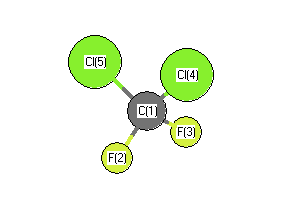Vibrational Frequencies calculated at B2PLYP=FULLultrafine/6-31G**
| Mode Number |
Symmetry |
Frequency
(cm-1) |
Scaled Frequency
(cm-1) |
IR Intensities
(km mol-1) |
Raman Act
(Å4/u) |
Dep P |
Dep U |
|---|
| 1 |
A1 |
1144 |
1144 |
313.46 |
1.19 |
0.70 |
0.82 |
| 2 |
A1 |
666 |
666 |
16.62 |
5.38 |
0.00 |
0.00 |
| 3 |
A1 |
454 |
454 |
0.17 |
8.26 |
0.23 |
0.37 |
| 4 |
A1 |
266 |
266 |
0.00 |
3.54 |
0.66 |
0.79 |
| 5 |
A2 |
323 |
323 |
0.00 |
1.75 |
0.75 |
0.86 |
| 6 |
B1 |
914 |
914 |
436.57 |
2.30 |
0.75 |
0.86 |
| 7 |
B1 |
436 |
436 |
0.07 |
3.97 |
0.75 |
0.86 |
| 8 |
B2 |
1227 |
1227 |
226.29 |
0.33 |
0.75 |
0.86 |
| 9 |
B2 |
436 |
436 |
1.19 |
2.09 |
0.75 |
0.86 |
Unscaled Zero Point Vibrational Energy (zpe) 2932.1 cm
-1
Scaled (by 1) Zero Point Vibrational Energy (zpe) 2932.1 cm
-1
See section
III.C.1 List or set vibrational scaling factors
to change the scale factors used here.
See section
III.C.2
Calculate a vibrational scaling factor for a given set of molecules
to determine the least squares best scaling factor.
Charges, Dipole, Quadrupole and Polarizability
Charges from optimized geometry at B2PLYP=FULLultrafine/6-31G**
Charges (e)
| Number |
Element |
Mulliken |
CHELPG |
AIM |
ESP |
| 1 |
C |
0.378 |
|
|
|
| 2 |
F |
-0.222 |
|
|
|
| 3 |
F |
-0.222 |
|
|
|
| 4 |
Cl |
0.033 |
|
|
|
| 5 |
Cl |
0.033 |
|
|
|
Electric dipole moments
Electric dipole components in Debye
(What's a Debye? See section
VII.A.3)
| |
x |
y |
z |
Total |
| |
0.000 |
0.000 |
-0.217 |
0.217 |
| CHELPG |
|
|
|
|
| AIM |
|
|
|
|
| ESP |
|
|
|
|
Electric Quadrupole moment
Quadrupole components in D Å
| Primitive |
|---|
| | x | y | z |
|---|
| x |
-39.153 |
0.000 |
0.000 |
| y |
0.000 |
-40.867 |
0.000 |
| z |
0.000 |
0.000 |
-40.027 |
|
| Traceless |
|---|
| | x | y | z |
|---|
| x |
1.295 |
0.000 |
0.000 |
| y |
0.000 |
-1.277 |
0.000 |
| z |
0.000 |
0.000 |
-0.017 |
|
| Polar |
|---|
| 3z2-r2 | -0.035 |
|---|
| x2-y2 | 1.715 |
|---|
| xy | 0.000 |
|---|
| xz | 0.000 |
|---|
| yz | 0.000 |
|---|
|
Polarizabilities
Components of the polarizability tensor.
Units are
Å
3 (Angstrom cubed)
Change units.
| |
x |
y |
z |
| x |
6.135 |
0.000 |
0.000 |
| y |
0.000 |
3.315 |
0.000 |
| z |
0.000 |
0.000 |
4.234 |
<r2> (average value of r
2) Å
2
| <r2> |
157.243 |
| (<r2>)1/2 |
12.540 |
